This website is supported by its readers. If you click one of my links I may earn a commission. I am also a participant in the Amazon affiliates program and I will also earn a commission from qualified purchases.
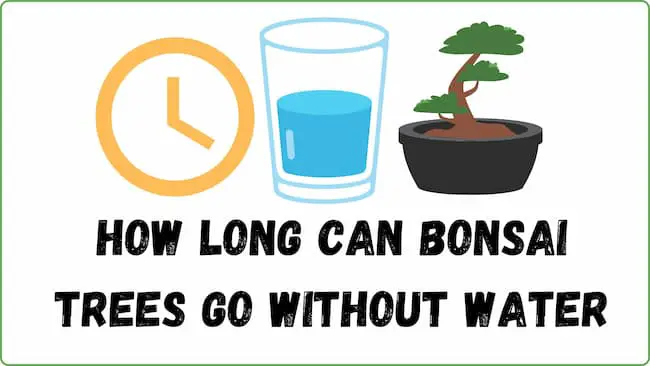
One of the things I was most nervous about when I started my journey growing bonsai was leaving my trees without watering. After all, I’ve heard many horror stories about people going on vacation only to come back and find that their bonsai has unfortunately died. So how long can bonsai trees go without water?
Bonsai trees should not be left without water for more than a week. Most bonsai trees need to be watered once to twice per week in the spring, summer, and fall and about once every one to two weeks in winter.
Succulent bonsai species such as Jade should be watered less frequently. Always check the topsoil of your bonsai is dry to the touch before watering.
So what bonsai species need to be warted more than others? And do bonsai trees need to be watered daily, weekly, or monthly? Keep reading to find out more!
Just a quick heads up, over the past three years of running Plantpaladin, hundreds of people have asked for product recommendations. As such, You can find my favorite indoor bonsai tree here (link takes you to Bonsaiboy), my favorite outdoor bonsai tree (link takes you to Bonsaiboy), or have a look at all the products I recommend here.
How long can bonsai go without water?
To know precisely how long bonsai trees can go without water, I reached out to a few bonsai experts, visited my local botanical gardens, and even got in touch with twenty plant paladin readers.
All to ensure you had the most in-depth article on how long bonsai trees can go without water.
To summarize:
How long can bonsai go without water – quick facts
- Most bonsai trees will need to be watered on average every three days.
- As such, most bonsai and beginner-friendly bonsai trees such as Ficus, Elm, or Fukien Tea only need to be watered about twice per week.
- The major exception to this, however, is if you keep your bonsai tree outdoors or in a cold frame during winter.
- If this is the case, water your bonsai once every one to two weeks.
- Bonsai trees kept outdoors can typically go longer between you directly watering them due to rainfall.
- Watering your bonsai tree twice a week will work best during the spring, summer, and fall.
- To check if your bonsai tree needs watering, touch the topsoil of your bonsai. If dry to the touch, your tree needs watering.
- Checking your bonsai for dry soil should be undertaken daily, especially in warmer climates or in the summer when the drier conditions can lead to a risk of underwatering.
- Most beginner-friendly bonsai species are very forgiving, and so if you miss the odd watering for two weeks or so by being on vacation, then trees like elm or ficus will usually be able to recover.
- However, do not make a habit of leaving your bonsai tree without water for too long, as leaving for more than a few weeks will result in your tree dying.
- Succulent bonsai species, such as Jade, require watering less frequently than hardy bonsai, such as willows.
- The larger your bonsai tree, the more water it will require too.
- Bonsai trees may be able to go longer in between watering if high-quality water such as filtered water or rainwater.
How long can bonsai go without water – comparison table
I’ve also created a table below that goes into how long a bonsai tree will go without water:
Timescale | Will bonsai survive |
1 day | Yes, can easily go a day without watering |
1 week | Yes, the vast majority of bonsai trees can go 1 week without water, so long as temperatures are mild and it is not a regular occurrence |
1 month | No, most bonsai trees will need watering much more frequently than once per month, only succulent species will recover. |
1 year | No bonsai tree will be able to survive with no watering for a year. |
Now that was quite a lot of information to go through so let’s break this down in a little more detail.
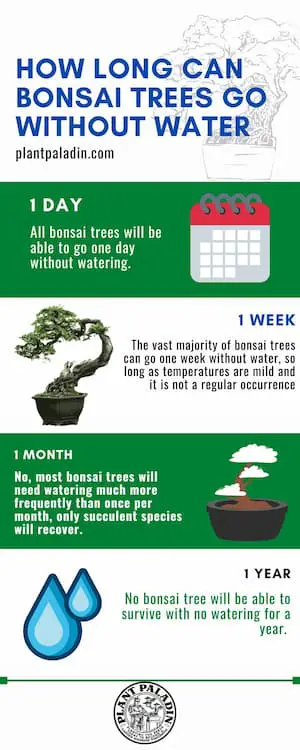
Considerations for how long can bonsai trees go without water?
So while most bonsai trees need watering at least once per week, there are several other considerations you need to be aware of that will impact how frequently you can go between watering your bonsai tree.
This includes:
- The age of your bonsai
- Its size classification
- Your bonsai tree species
- If your bonsai is healthy
- If the tree is kept indoors or outdoors
- The season
- How warm is your climate
- The quality of the water used
Can a bonsai tree survive a day without water?
All bonsai tree species can survive a day without water regardless of age, size, and climate. Most species will only need to be watered around twice per week.
However, the only exception to this rule is if the external temperatures are sweltering and fall well outside your tree’s normal safe temperature range.
If a heatwave at these extreme temperatures occurs, consider watering your bonsai tree daily – especially if you keep your bonsai outdoors.
Can a bonsai tree survive a week without water?
Most bonsai trees will survive a week without water so long as this is not a common occurrence. However, the major exception will be bonsai trees that are very water dependent, such as willows, younger tree seedlings, or fingertip-sized bonsai that require more constant care.
Can a bonsai survive a month without water?
Bonsai trees will not be able to survive a month without water. Even succulent species that require watering less frequently will still need to be watered every few weeks. As such, you must water your bonsai tree weekly to prevent it from drying out.
While watering your bonsai will not need to be undertaken as frequently in winter, watering once per month in winter is not recommended as this, too, is too long to go in between watering sessions.
If you need to go a few weeks without watering your bonsai tree, consider housing a humidity tray, which can add valuable water back into your tree if you are unable to water your tree as frequently as you would like.
Can a bonsai tree survive a year without water?
No bonsai trees, regardless of subspecies, will be able to survive for a year without water. Without watering your tree for a few weeks, your bonsai tree will start to wilt, and after a year of watering, your bonsai tree will be dead.
Unlike not watering for a few weeks or even a month when you can revive the bonsai tree, if you leave it longer than a year in between watering your bonsai, there will be zero chance of reviving your bonsai.
Do you need to water your bonsai if you are on vacation?
If you are going on vacation for more than a week away from your bonsai tree, you will need help watering your tree.
Luckily there are a few things you can do if you are away.
I went on vacation earlier this year, and so these steps helped me massively:
Get someone to water your bonsai
The best option is to get a friend or relative to pop over to your home and water your tree.
I left my keys with my mom and told her exactly how to water the different trees.
The good news is once you have given the instructions once (and most importantly, they do an excellent job of it), you can get them to do the process again in the future.
Use a humidity tray
While the actual scientific evidence on the benefits of humidity trays is a little sketchy, I found that using humidity trays works well at providing your tree with water if you are away for a week or so.
Humidity trays will allow your bonsai tree to get air and moisture in its system still.
Now to figure out exactly how to use a humidity tray, I’ve written a post, which you can check out here.

Sphagnum moss
Another great option to water your bonsai if you are away is sphagnum moss.
Sphagnum moss can hold up to 8 times its weight in water, so placing a few buts of sphagnum moss on the trunk and topsoil of your tree should be enough to keep your tree moist for a week or so.
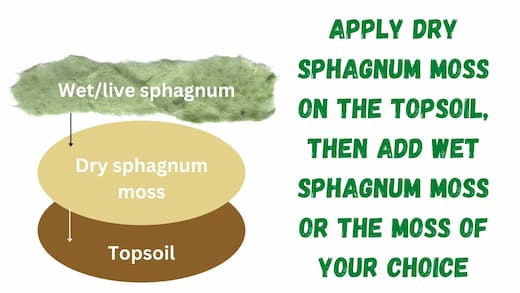
Garden daycare
Now, if you are limited in the number of people who can care for your tree or need more time to ask for a favor, one option that is becoming more popular is to opt for plant daycare.
These nurseries and daycare centers will allow you to drop off your bonsai tree to them for a few and they will care for your tree until you are back.
Just be warned; however, I would not do this for bonsai species that are very particular about changes in location or temperature, such as willows or olive subspecies.
How long can bonsai trees go without water through the seasons?
Bonsai trees can typically go longer without water during the winter stage than during the spring and summer.
This is provided that your bonsai does indeed enter the winter dormancy stage.
During dormancy, your bonsai tree enters a period of stasis, and most of its functions are slowed down. (if not, continue watering your bonsai once to twice per week)
During winter, your bonsai tree will only need to be watered once every one to two weeks. The rainfall and cold, damp temperatures will typically be enough to water your bonsai in between direct watering sessions.
This ensures that you live in a cold climate during winter with cold, wet winters.
During the spring, summer, and fall, watering should be kept to around once every few days, with more care being taken in the summer, especially in hotter, drier climates.
If you reside in hotter conditions, consider checking for watering daily during summer and choose bonsai tree species that thrive in the warmth, such as tropical trees like Ficus or Olive.
To help show how long can bonsai and trees go without water during the different seasons, I’ve pulled together a table below:
Season | How long between watering |
Spring | Water once to twice per week- Every 3 days |
Summer | Check if the topsoil is dry to touch daily.l If dry, water. If not, water once to twice per week. |
Fall | Water once to twice per week - Every 3 days. |
Winter | Water once every one to two weeks. |
Does age impact how long your bonsai tree can go without water?
The age of your bonsai tree will also impact how long your bonsai tree can go without water. Younger bonsai trees at the seedling stage or older bonsai trees over 70 years old will require more day-to-day care than most 5 to 50-year-old bonsai trees.
As such, increase how frequently you check the topsoil of these bonsai trees to see if they need watering.
In this scenario, checking the topsoil daily will be your best bet to prevent both over and underwatering of your bonsai, especially in older trees.
Does climate impact how long your bonsai tree can go without water?
So while the recommendations in this post are for bonsai trees in temperate climates, what about those of you reading this who live in strong weather conditions?
The truth is, how long your bonsai tree can go without water will depend on the climate you keep your bonsai tree in
This includes:
- If you keep your bonsai outdoors vs. indoors
- The average sunlight and heat per year
- The average rainfall per year
Outdoor vs. indoors
If you keep your bonsai tree outdoors, it is more exposed to the temperatures.
As such, this means you have many more factors that can impact how frequently you water your bonsai tree.
For example, If you keep your bonsai tree outdoors and there is a lot of wind in your climate, then this will naturally strip away a lot of the water from your tree.
In this scenario, you will likely need to water your bonsai tree more frequently.
If, however, you keep your bonsai tree indoors, you have control of almost all aspects of the tree care, leaving nothing to chance.
This means that you can typically water your bonsai tree with a schedule without any real consequences.
Sunlight and heat per year
If the climate you reside in has bright sunny days with warm temperatures throughout most of the year, then this will also mean your bonsai tree will require more watering daily.
The dry air and sunny temperatures will dry your soil and the moisture out, meaning you need to take note of this.
If the bonsai tree species you own is being kept at a temperature outside of its natural temperature range, you will need to take extra care.
For example, If you own a juniper bonsai and the temperature regularly exceeds 35 degrees celsius, this is typically higher than the ideal juniper bonsai temperature range.
As such, you will likely need to have more frequent watering of said juniper to ensure it does not dry out or burn.
To check the average temperature of your climate, check out this table here.
Rainfall
While much of this post is focused on ensuring your bonsai tree gets enough water between watering sessions, it can be just as vital to ensure you do not overwater your bonsai tree.
If you keep your bonsai tree outdoors and the climate you live in has a lot of natural rainfall, then the watering you will need to undertake will be limited.
Instead, consider the days when it has rained so you can plan when to check your bonsai tree for rainfall.
The only caveat to this would be for bonsai species that can be watered daily without any natural hesitation, such as Willows.
It’s worth taking note of your country’s climate by rainfall, so I suggest looking at the following table.
Does soil impact how long your bonsai tree can go without water?
Another primary consideration regarding how long your bonsai tree can go without water is just how good your potting soil is.
Bonsai tree potting soil has to do three main things, be it organic or inorganic.
- Retain moisture.
- Let moisture flow through.
- Aeration.
Usually, excellent bonsai tree potting soil will have even distributions of each.
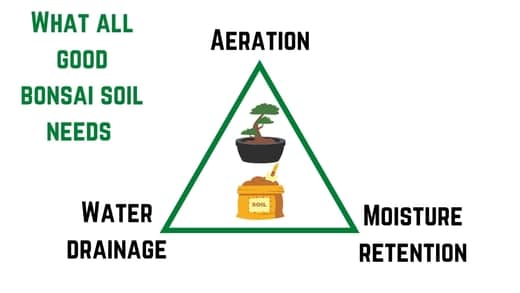
If you fiddle with the percentages, you can create potting soil that holds onto more water.
This will ensure that you can water your bonsai tree less frequently.
Alternatively, you should change potting soil once per year.
The reason?
Leaving your potting soil for too long changes the percentages of the three elements essential for good potting soil.
This often leads to potting soil allowing too much water to flow out of it, requiring more watering.
Bonsai tree size and watering?
Another critical consideration on how long can bonsai trees go without water is simply the size of your bonsai tree.
We touched upon this a little earlier, but most bonsai trees fall under different size classifications.
The smallest of these is often no more than one to two-inch fingertip-sized bonsai, the largest of which is a two-meter imperial-sized bonsai.
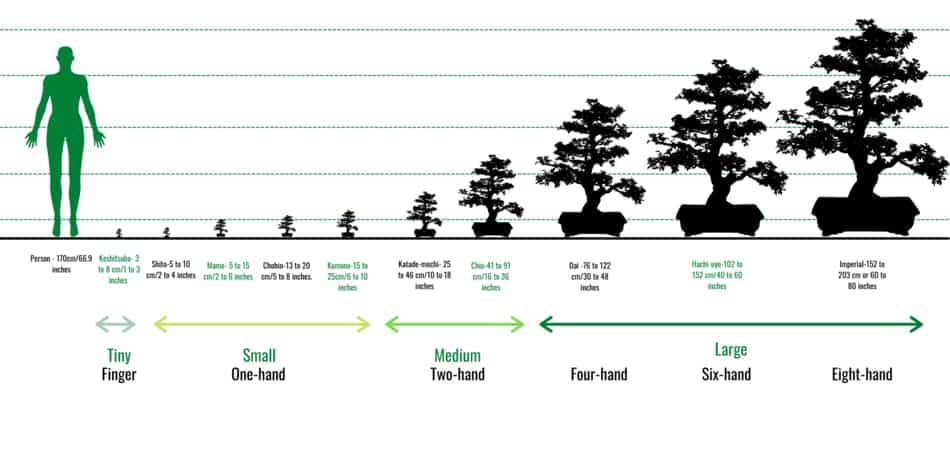
As such, smaller bonsai trees are much more likely to dry out faster than more giant bonsai trees, which means that more miniature bonsai should be checked a lot more frequently for watering and have a shorter time in between watering the more giant bonsai trees.
Larger imperial-sized bonsai will take longer for the water to settle and typically take longer to dry out than smaller trees.
To help explain the difference, I’ve pulled together a table below which goes into more detail on how often you should water a bonsai tree by size:
How long can bonsai go without water by size
Classification | Size inches | Size Centimeters | Hand size | General size | How often should you water |
Keshitsubo | 1 to 3 inches | 3 to 8 centimeters | Fingertip | Tiny | Every 2 days |
Shito | 2 to 4 inches | 5 to 10 centimeters | One-hand | Tiny | Every 2 days |
Mame | 2 to 6 inches | 5 to 15 centimeters | One-hand | Small | Every 2 days |
Chohin | 5 to 8 inches | 13 to 20 centimeters | One-hand | Small | Every 3 days |
Kumono | 6 to 10 inches | 15 to 25 centimeters | One-hand | Small | Every 3 days |
Katade-mochi | 10 to 18 inches | 25 to 46 centimeters | Two-hand | Medium | Every 4 days |
Chiu or Chumono | 16 to 36 inches | 41 to 91 centimeters | Two-hand | Medium | Every 4 days |
Dai or Omono | 30 to 48 inches | 76 to 122-centimeters | Four-hand | Large | Every 5 days |
Hachi-uye | 40 to 60 inches | 102 to 152 centimeters | Six-hand | Large | Every 6 days |
Imperial | 60 to 80 inches | 152 to 203 centimeters | Eight-hand | Large | Weekly |
Do bonsai need to be watered daily?
Most bonsai trees do not need to be watered daily. Instead, watering your bonsai tree one to two times per week will be enough for most species. During the summer, watering may need to be more frequent, so you should check the topsoil daily to see if your tree needs watering.
Does water quality impact how frequently you should water bonsai?
Another consideration you need to know about how long can bonsai trees go without water is what you water your bonsai tree with.
Not all water sources are created equal, and watering your bonsai with filtered water or rainwater will mean a healthier bonsai than watering with regular tap or bottled water.
The better water you use, the smaller the chance of fluoride, chlorine, and salt building up in your tree.
The build-up of these chemicals will ensure your tree becomes less efficient, which means you have to water your bonsai tree more often.
Water type | Rating (out of 10) |
Rainwater | 10 |
Filtered Water | 8 |
Distilled water | 5 |
Tap water | 5 |
Mineral/spring water | 5 |
Pondwater | 5 - 7 depending on tree species |
Fruit juices, cola other soft drunks | 2 |
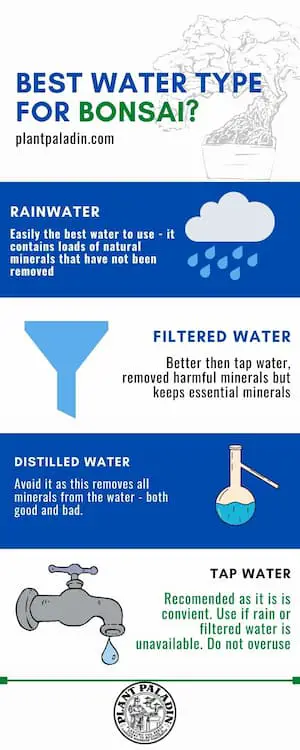
Can you overwater your bonsai?
Overwatering bonsai is common and can be undertaken with most bonsai regardless of subspecies. The main symptoms include yellowing leaves, fungi infections, and wet potting soil. To prevent this, ensure you only water when the topsoil of your bonsai tree is dry to the touch.
Most bonsai trees then will only need to be watered twice per week.
The good news if you have overwatered your bonsai tree is I’ve written a separate post covering this, which you can check out here.
Can you underwater your bonsai?
Underwatering bonsai trees is widespread if you go too long between watering your tree. Signs of an underwatered bonsai and dry, brittle leaves, drooping leaves, and posting soil that is very dry and dusty to the touch.
To prevent this, water your bonsai and tree immediately and then aim to water once to twice weekly for best results.
What are the signs you need to water your bonsai?
The main sign that you have gone too long in between watering your bonsai tree is by checking the topsoil of your bonsai.
Place your index finger about half an inch to an inch deep in the potting soil of your bonsai tree.
Repeat this in two or three different spots.
If your finger is completely dry when you pull your finger out, then your bonsai tree will need watering.
If, however, you pull your finger out and it is moist, damp, or wet to the touch, water your bonsai.
Other options and signs you need to watch your bonsai are dry leaves turning brown.
Dry, brittle branches or a bonsai tree that is more susceptible to fungal, bacterial, or insect infestations.
As a general rule of thumb, aim to go up to three days to one week without watering your bonsai, as this will work for most bonsai regardless of species, size, age, location, or climate.
How long can bonsai tree species go without water?
So without a doubt, the most significant factor that will determine how long bonsai can go without water is simply the species that you have.
For example, succulent species such as jade bonsai can go one to two weeks between catering.
Other bonsai, however, that require more care, such as willow or fruiting bonsai, such as orange, lime, or apple tree bonsai, will need watering much more frequently.
As such, you need to take note of the species you own before deciding how frequently you should check it for watering.
To help, I’ve pulled together a table of several of the most common bonsai tree species as well as how frequently you ended up watering them:
bonsai tree species vs. how long they can go without water
Bonsai Species | How often should topsoil be checked | How often should the bonsai tree be watered |
Weeping Willow | A few times per day | Daily |
Birch | A few times per day | Daily |
Alder | A few times per day | Daily |
Apple | Once per day | A few times per week when not producing fruit. Daily when producing fruit. |
Lemon | Once per day | A few times per week when not producing fruit. Daily when producing fruit. |
Lime | Once per day | A few times per week when not producing fruit. Daily when producing fruit. |
Orange | Once per day | A few times per week when not producing fruit. Daily when producing fruit. |
Crabapple | Once per day | A few times per week when not producing fruit. Daily when producing fruit. |
Cherry | Once per day | A few times per week when not producing fruit. Daily when producing fruit. |
Ficus | Once per day | Daily to a few times per week. |
Chinese Elm | Once per day | Daily to a few times per week. |
Fukien Tea | Once per day | Daily to a few times per week. |
Serissa | Once per day | Daily to a few times per week. |
Olive | Once per day | Daily to a few times per week. |
Juniper | Once per day | Daily to a few times per week. |
Pine | Once per day | Daily to a few times per week. |
Scots Pine | Once per day | Daily to a few times per week. |
Oak | Once per day | Daily to a few times per week. |
Jade | Once per day | Daily to a few times per week. |
Should your bonsai always be wet?
You should avoid your bonsai tree being permanently wet. This is because too much moisture will lead to overwatering of your tree. This can lead to your bonsai having yellowing leaves or leaves that drop off and, in severe cases, develop root rot and other fungal infections.
Survey results on how long bonsai trees can go without water
Finally, I didn’t want to use my experience to decide how long bonsai trees can go without water, so I got in touch with twenty plant paladin readers and asked how frequently they water their trees.
To summarize:
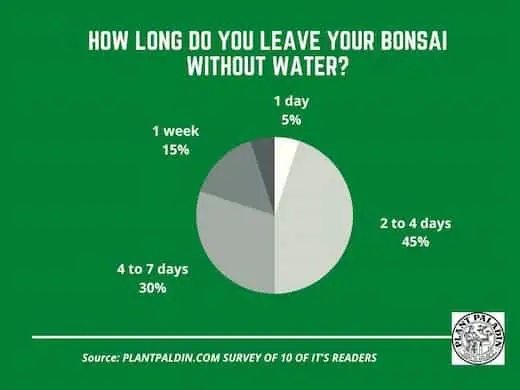
I also spoke with one of the employees at my local botanical gardens, and this was their response:
“We check the bonsai daily for watering but, on average, water them about once per week.”
My top picks for the gear you will need!
So like I mentioned earlier, over the past three years of running PlantPaladin, hundreds of people have asked me for my recommendations on the best bonsai gear on the market.
Having spent thousands of dollars on bonsai items these past few years and tested at least 100 bonsai-specific products, I’ve listed my favorite products below – All of which I highly recommend and think you can get great value.
They can purchase directly by clicking the link to take them to Amazon.
Bonsai Tool Set: One of the significant challenges I’ve had is finding a toolset that was not only durable but didn’t break the bank. SOLIGT has recently developed a fantastic bonsai tool set that covers all the tools you need to trim, prune, and repot your trees. – You can grab it here.
Complete Bonsai Set: Many of you will want to grow your bonsai trees entirely from scratch, but finding the varicose seeds, pots, and other items in one place can be challenging. Leaves and Sole then have created a complete bonsai set that I’ve personally used that ticks all the boxes. You can grab it here.
Bonsai wire: The number of times I’ve run out of wire for my bonsai or purchased cheap bonsai wire that doesn’t do the job is embarrassing for me to admit. After a lot of trial and error, I found that using Hotop’s aluminum bonsai wire is one of the best options on the market. This can easily be used for both indoor and outdoor bonsai. You can grab it here.
This post was written by Fehed Nicass who has been passionate about bonsai for over 3 years.
